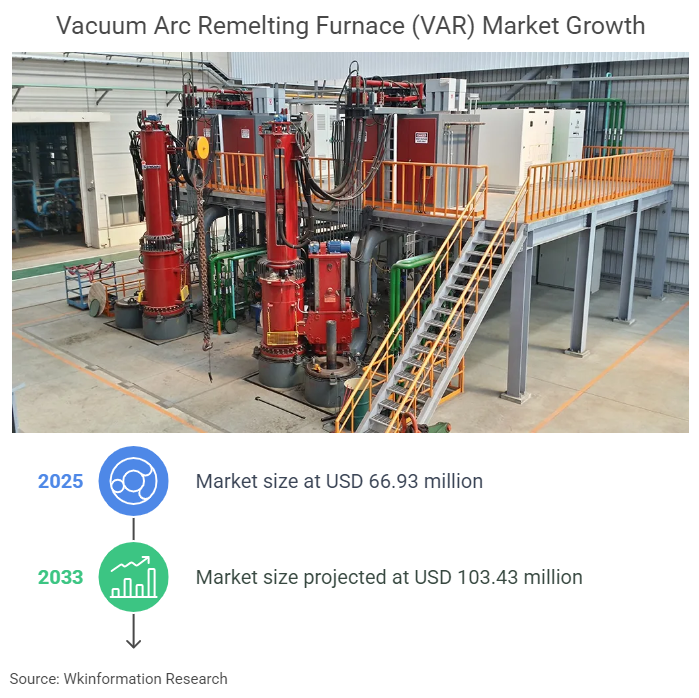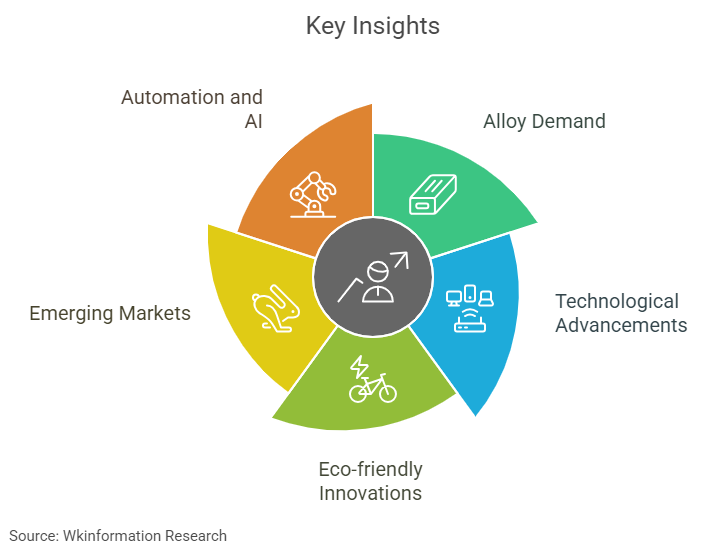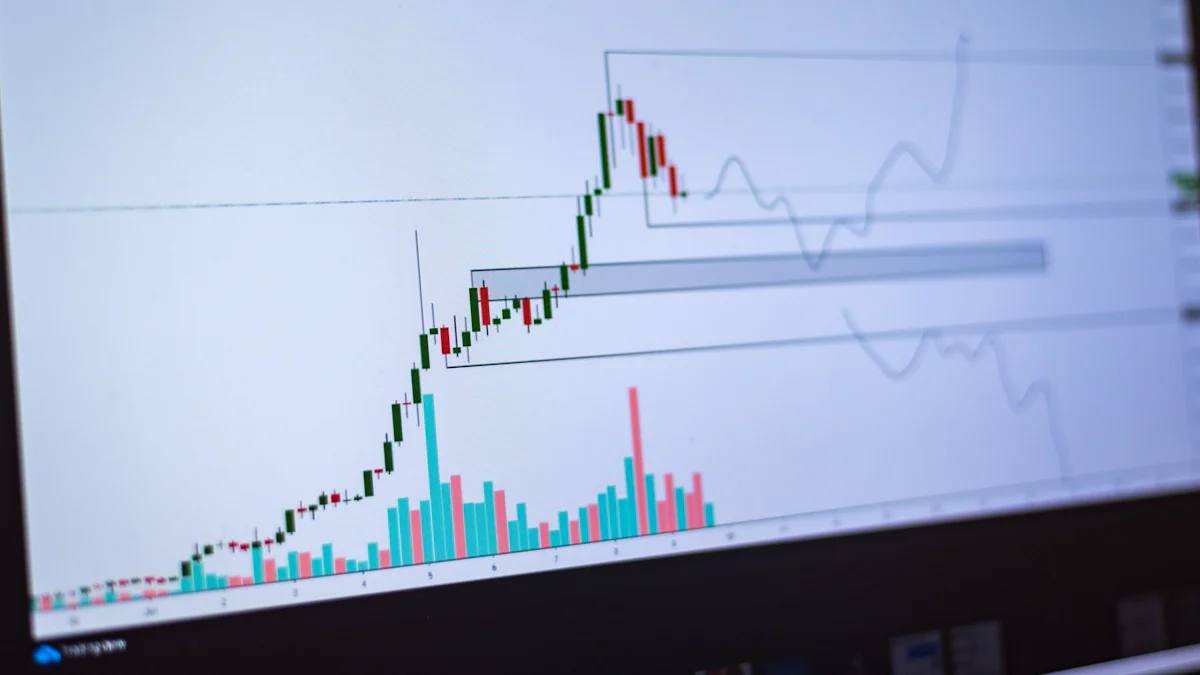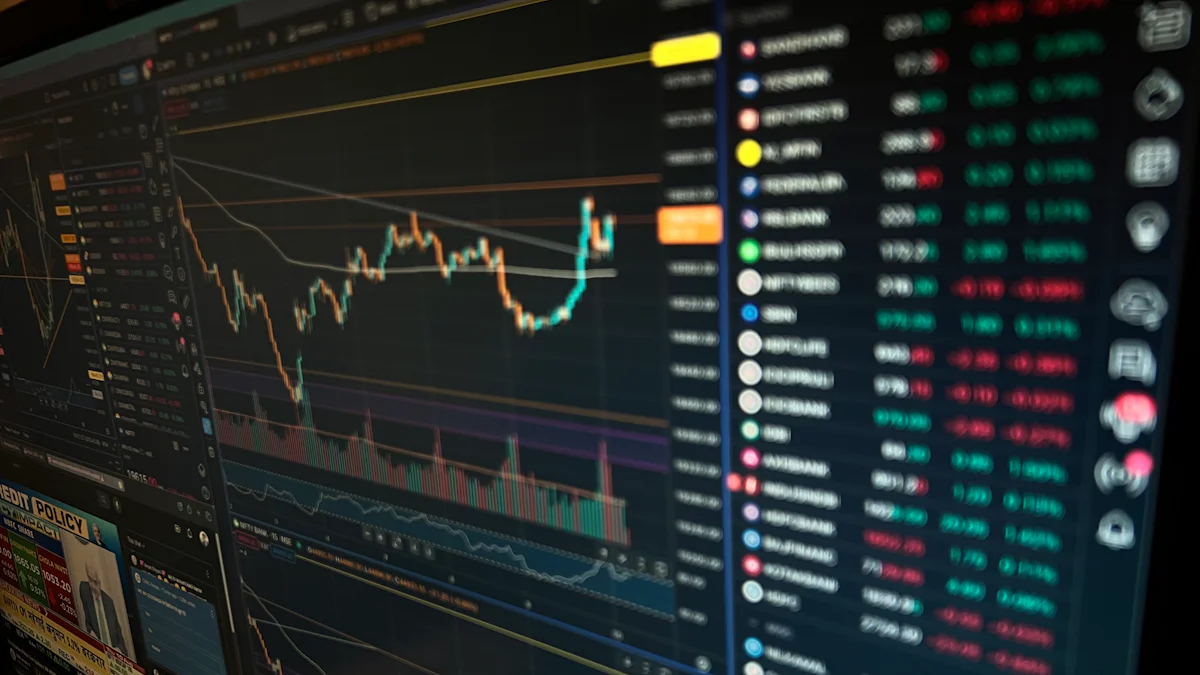
The vacuum arc remelting furnace (VAR) market is set to expand at a compound annual growth rate (CAGR) of 5.59% from 2025 to 2033. Market size projections indicate growth from USD 66.93 million in 2025 to USD 103.43 million by 2033. Increasing demand for high-quality alloys in aerospace, automotive, and energy sectors drives this expansion. Technological advancements in VAR systems enhance efficiency and output, while sustainability initiatives promote eco-friendly processes. Rising investments in research and development further accelerate the adoption of VAR technologies, particularly in industries requiring titanium and superalloys.
Key Insights
- The VAR market is expected to grow 5.59% yearly from 2025 to 2033. This is due to the need for better alloys in big industries.
- New technology in VAR systems makes them work faster and better. They are important for making strong, high-quality materials.
- Eco-friendly ideas are changing the VAR market. Companies now focus on saving energy and using greener methods.
- Growing countries are using VAR technology quickly. This is because their industries are growing and need very pure metals.
- Using automation and AI in VAR systems helps save money. It also makes work faster and improves material quality.

Market Overview
What is a Vacuum Arc Remelting Furnace (VAR)?
A vacuum arc remelting furnace (VAR) is a specialized metallurgical device used to refine and enhance the quality of metal alloys. It operates by melting a consumable electrode under a vacuum using an electric arc. This process eliminates impurities, reduces gas content, and ensures uniformity in the final product. VAR furnaces are essential for producing high-performance materials, including titanium, nickel superalloys, and stainless steel. These materials are critical in industries requiring exceptional strength, durability, and resistance to extreme conditions.
In 2025, the global market size for vacuum arc remelting furnaces was valued at approximately USD 66.93 million. This figure underscores the growing importance of VAR technology in meeting the demand for advanced materials across various sectors. The precision and reliability of VAR systems make them indispensable in applications where material integrity is paramount.
Importance of VAR in Biomedical Applications and Other Sectors
The vacuum arc remelting furnace (VAR) market plays a pivotal role in biomedical applications, particularly in the production of biomaterials. These materials, such as titanium alloys and stainless steel, are widely used in orthopedic implants and cardiovascular implants due to their biocompatibility. The VAR process ensures the purity and homogeneity of these materials, which is crucial for their performance in medical devices. For instance, titanium alloys like Ti-6Al-4V are preferred for their strength, corrosion resistance, and compatibility with human tissues.
Beyond the biomedical field, VAR furnaces contribute significantly to other industries. In aerospace, they produce nickel superalloys like Inconel and Hastelloy, which withstand high temperatures and stress. In power generation, VAR systems refine materials for turbines and reactors.
The versatility of VAR technology ensures its relevance across diverse applications, from industrial manufacturing to cutting-edge biomedical innovations.
Key Trends Shaping the Vacuum Arc Remelting Furnace (VAR) Market

Technological Advancements in VAR Systems
The vacuum arc remelting furnace (VAR) market is experiencing rapid technological progress. Manufacturers are prioritizing the development of energy-efficient systems to meet the growing demand for high-quality, low-impurity metals. Enhanced control systems and automation are transforming VAR operations, improving efficiency and output. These advancements attract more manufacturers to invest in VAR technologies, ensuring their relevance in modern industrial processes.
The integration of automation and digitalization in manufacturing further optimizes VAR systems. Automated processes reduce human error and enhance precision, making VAR furnaces indispensable for producing high-performance alloys.
Increasing Demand in Aerospace and Defense Industries
The aerospace and defense sectors rely heavily on VAR technology for producing high-performance alloys. These industries demand materials capable of withstanding extreme conditions while maintaining durability and performance. Lightweight, high-strength alloys refined through VAR processes meet these stringent requirements, making them essential for aerospace components and defense equipment.
Nations worldwide are modernizing their defense capabilities, driving the demand for specialized alloys. The aerospace sector, in particular, requires materials like titanium and nickel superalloys for applications such as jet engines and structural components. The ongoing growth in these industries ensures a steady rise in VAR adoption.
Sustainability Initiatives Driving Eco-Friendly VAR Technologies
Sustainability is a critical focus in the VAR market. Manufacturers are developing eco-friendly VAR technologies to reduce energy consumption and minimize environmental impact. Energy-efficient systems not only lower operational costs but also align with global sustainability goals. These innovations position VAR systems as a sustainable solution for industries seeking to reduce their carbon footprint.
The adoption of green technologies in VAR operations reflects a broader industry trend toward environmental responsibility. By prioritizing sustainability, the VAR market addresses regulatory pressures and meets the expectations of environmentally conscious consumers.
Rising Adoption in Emerging Economies
Emerging economies are witnessing a surge in the adoption of vacuum arc remelting furnace (VAR) systems. This growth stems from several factors driving industrial expansion and technological advancements in these regions.
- Demand for High-Performance Metals: Industries in emerging markets increasingly require high-purity metals for aerospace, automotive, and medical manufacturing. VAR systems meet these demands by producing materials with exceptional quality and consistency.
- Economic Growth and Investments: Rapid industrialization in countries like India, Brazil, and Vietnam has led to significant investments in aerospace and automotive sectors. These industries rely on VAR technologies to manufacture components that meet stringent performance standards.
- Sustainability and Energy Efficiency: The global push for sustainable manufacturing practices has influenced emerging economies. VAR systems, known for their energy-efficient processes, align with these goals, making them an attractive choice for manufacturers.
- Technological Advancements: Innovations in VAR systems have enhanced operational efficiency, reducing costs and increasing output. These improvements make VAR technology more accessible to industries in developing regions.
The vacuum arc remelting furnace (VAR) market in emerging economies is poised for steady growth. As these regions continue to industrialize, the demand for advanced manufacturing technologies will further accelerate VAR adoption.
Integration of Automation and AI in VAR Operations
Automation and artificial intelligence (AI) are revolutionizing VAR operations, enhancing efficiency and precision. Manufacturers are integrating automation into VAR systems by connecting customer relationship management (CRM) and enterprise resource planning (ERP) systems. This seamless connection streamlines processes such as quoting and order management. Data automatically transfers between systems, reducing manual errors and improving supply chain management.
AI-powered control systems are also transforming VAR operations. These systems monitor and adjust parameters in real time, ensuring optimal performance. For example, AI algorithms analyze data from sensors to maintain consistent arc stability during the remelting process. This precision minimizes defects and enhances the quality of the final product.
The integration of automation and AI offers several benefits:
- Improved Efficiency: Automated processes reduce human intervention, speeding up production cycles.
- Enhanced Accuracy: AI-driven systems ensure precise control over critical variables, resulting in superior material quality.
- Cost Reduction: Automation lowers operational costs by minimizing waste and energy consumption.
As industries adopt these advanced technologies, VAR systems become more reliable and cost-effective. The combination of automation and AI positions VAR technology as a cornerstone of modern manufacturing.
Market Segmentation Analysis
By Type
Stationary VAR Furnaces
Stationary vacuum arc remelting furnaces dominate the market due to their robust design and high production capacity. These systems are ideal for large-scale operations in industries like aerospace, power generation, and the global titanium industry. Their ability to produce high-purity metals with consistent quality makes them indispensable in advanced manufacturing technologies. Stationary furnaces are widely used in the titanium industry, where precision and reliability are critical. Their application in producing magnesium-based alloys further highlights their versatility.
Portable VAR Furnaces
Portable vacuum arc remelting furnaces cater to niche applications requiring mobility and flexibility. These systems are particularly useful in research and development settings or small-scale production facilities. Their compact design allows manufacturers to refine materials like magnesium and titanium on-site, reducing transportation costs and improving efficiency. Portable furnaces are gaining traction in emerging economies, where industries seek cost-effective solutions for producing high-performance materials.
By Application
Aerospace and Defense
The aerospace and defense sectors rely heavily on VAR systems for producing high-strength alloys. These materials withstand extreme conditions, making them essential for jet engines, structural components, and defense equipment. The demand for lightweight, durable materials continues to drive the adoption of VAR technology in these industries.
Power Generation
VAR furnaces play a crucial role in the power generation sector. They refine materials used in turbines, reactors, and other critical components. The ability to produce high-purity metals ensures the reliability and efficiency of power generation systems.
Biomedical Applications
The biomedical sector benefits significantly from VAR technology, particularly in the production of biomaterials. Titanium alloys and magnesium-based alloys are widely used in orthopedic implants and other medical devices due to their biocompatibility. The VAR process ensures the purity and homogeneity of these materials, enhancing their performance in biomedical applications. As the demand for advanced biomaterials grows, the role of VAR systems in the biomedical industry becomes increasingly important.
Industrial Manufacturing
Industrial manufacturing relies on VAR furnaces to produce high-quality alloys for various applications. These systems ensure the consistency and durability of materials used in automotive, construction, and other industrial sectors. The adoption of VAR technology in industrial manufacturing highlights its importance in producing reliable and efficient components.
Regional Insights

North America: Growth Drivers and Challenges
North America remains a significant market for vacuum arc remelting furnaces (VAR), driven by the region’s advanced technological landscape. The adoption of cutting-edge technologies, including cloud computing and cybersecurity solutions, has bolstered the demand for high-performance materials. Industries across North America are undergoing digital transformation, which increases the need for customized software and robust IT infrastructure. These factors collectively support the growth of the VAR market.
The aerospace and defense sectors in North America also contribute to the market’s expansion. These industries require high-quality alloys for critical applications, ensuring consistent demand for VAR systems. However, challenges such as fluctuating raw material prices and stringent environmental regulations may impact market growth. Companies must navigate these hurdles by investing in sustainable practices and innovative technologies.
Europe: Focus on Sustainability and Innovation
Europe’s VAR market is characterized by its strong emphasis on sustainability and innovation. Businesses in the region are increasingly adopting eco-friendly solutions to align with market demands and regulatory requirements. Companies that adapt to these changes gain a competitive edge, fostering innovation in VAR technologies.
Key trends shaping the European VAR market include:
- Technological Advancements: The integration of AI, IoT, and automation enhances operational efficiency.
- Customization and Personalization: Industries demand tailored solutions to meet specific requirements.
- Sustainability Initiatives: Eco-friendly practices are becoming essential as environmental awareness grows.
- Digital Transformation: The shift toward digital solutions creates new opportunities for growth.
- Strategic Partnerships: Collaborations with industry leaders drive innovation and expand market access.
Europe’s focus on sustainability and technological progress positions it as a leader in the global VAR market.
Asia-Pacific: Rapid Industrialization and Market Expansion
The Asia-Pacific region is experiencing rapid industrialization, making it the fastest-growing market for VAR systems. Expanding manufacturing capabilities and rising investments in infrastructure projects are key drivers of this growth. The region’s focus on high-quality manufacturing further accelerates the adoption of advanced technologies like VAR.
Asia-Pacific also presents significant opportunities for market expansion. Technological advancements, evolving regulatory frameworks, and rising consumer demand for sustainable solutions create a favorable environment for growth. Government initiatives promoting modernization and international trade partnerships further support the VAR market. As disposable incomes rise, industries in the region are shifting toward higher-value products, driving further adoption of VAR technologies.
Rest of the World: Emerging Opportunities in Niche Markets
The vacuum arc remelting furnace (VAR) market in regions outside the major industrial hubs is witnessing growth in niche applications. These markets, often overlooked, present unique opportunities for manufacturers and investors. Industries in these regions are increasingly adopting VAR systems to meet specialized demands, driven by advancements in technology and evolving industrial needs.
Emerging economies in Latin America, the Middle East, and Africa are key contributors to this growth. These regions are investing in infrastructure and industrial development, creating a demand for high-performance materials. For instance, the aerospace and energy sectors in the Middle East are expanding rapidly, requiring advanced alloys produced through VAR processes. Similarly, Latin America’s growing automotive and biomedical industries are driving the need for high-purity metals.
The rise of mobile VAR solutions is another notable trend in these regions. Mobile-first industries, particularly in Africa, are leveraging portable VAR furnaces for on-site material refinement. This approach reduces logistical challenges and enhances operational efficiency.
Manufacturers targeting these regions must focus on affordability and adaptability. Portable VAR systems, with their cost-effective and versatile designs, align well with the needs of these markets. Additionally, governments in these regions are introducing policies to attract foreign investments, further boosting the adoption of advanced manufacturing technologies.
The rest of the world offers untapped potential for VAR systems. By addressing the unique challenges and demands of these niche markets, stakeholders can unlock significant growth opportunities and establish a competitive edge in the global VAR industry.
Competitive Landscape
Major Players in the Vacuum Arc Remelting Furnace (VAR) Market
The global vacuum arc remelting furnace (VAR) market features a competitive landscape dominated by several key players. These companies drive innovation and set industry standards through their advanced technologies and extensive expertise. Prominent players include:
- ALD Vacuum Technologies
- Consarc
- AMG Advanced Metallurgical Group
- Retech Systems LLC
- Inductotherm Group
- Seco/Warwick S.A.
- PVA TePla AG
- Ipsen International GmbH
- ECM Technologies
- TAV Vacuum Furnaces SpA
- Tenova S.p.A.
- Nabertherm GmbH
- Solar Manufacturing
- Centorr Vacuum Industries
- Thermal Technology LLC
- GfE Metalle und Materialien GmbH
- IHI Machinery and Furnace Co., Ltd.
- Advanced Vacuum Systems, Inc.
- VAC AERO International Inc.
- HHV Ltd.
- Materials Research Furnaces, LLC
These companies maintain their market positions by offering cutting-edge solutions tailored to the needs of industries such as aerospace, biomedical, and power generation.
Market Share Analysis
Market share distribution in the VAR industry reflects the dominance of established players with robust manufacturing capabilities and global reach. Companies like ALD Vacuum Technologies and Consarc lead the market due to their extensive product portfolios and strong customer relationships. Emerging players, particularly in Asia-Pacific, are gaining traction by leveraging cost-effective production methods and targeting niche applications.
The competitive dynamics also highlight the importance of regional expertise. European manufacturers excel in sustainability-focused innovations, while North American firms prioritize technological advancements. In contrast, companies in emerging economies focus on affordability and scalability to meet growing industrial demands. This diverse market structure ensures healthy competition and continuous innovation.
Key Strategies Driving Competition
Leading VAR manufacturers employ a variety of strategies to maintain their competitive edge. These strategies focus on enhancing operational efficiency, improving customer satisfaction, and ensuring regulatory compliance. Key approaches include:
- Maximizing Margins: Companies utilize real-time data to optimize pricing and inventory management.
- Streamlining Processes: Tools that simplify quoting and order management reduce errors and improve speed.
- Enhancing Customer Retention: A comprehensive view of customer interactions helps exceed expectations.
- Fostering Collaboration: Internal and external communication tools ensure seamless information sharing.
- Ensuring Compliance: Updated systems help manage regulatory requirements effectively.
Additionally, firms adopt rapid response strategies to engage leads quickly and integrate intuitive CRM solutions to enhance communication. Regular training programs keep teams informed about the latest industry trends, ensuring competitiveness. These strategies collectively enable VAR companies to adapt to market demands and sustain growth in a dynamic environment.
Recent Mergers, Acquisitions, and Partnerships
The vacuum arc remelting furnace (VAR) market has witnessed significant consolidation through mergers, acquisitions, and strategic partnerships. These transactions reflect the industry’s focus on innovation, market expansion, and operational efficiency. Companies are leveraging these collaborations to strengthen their competitive positions and enhance their technological capabilities.
One notable acquisition involved World Wide Technology acquiring Softchoice. This transaction exemplifies the growing trend of companies seeking to integrate advanced technologies and expand their service offerings. By acquiring Softchoice, World Wide Technology gained access to a broader customer base and enhanced its ability to deliver cutting-edge solutions.
Strategic partnerships have also played a pivotal role in driving innovation within the VAR market. Leading manufacturers are collaborating with research institutions and technology providers to develop next-generation VAR systems. These partnerships aim to improve energy efficiency, reduce environmental impact, and meet the growing demand for high-performance materials. For example, collaborations between VAR manufacturers and aerospace companies have resulted in the development of alloys tailored for extreme conditions.
Mergers and acquisitions have enabled companies to expand their geographic reach. Firms are targeting emerging markets in Asia-Pacific and Latin America, where industrialization and infrastructure development are accelerating. These regions offer significant growth potential for VAR technologies, particularly in aerospace, biomedical, and power generation applications.
The VAR market’s dynamic landscape underscores the importance of strategic collaborations. Companies that prioritize innovation and adaptability through mergers, acquisitions, and partnerships will remain at the forefront of this evolving industry.
Future Outlook and Opportunities
Emerging Technologies in VAR Systems
Emerging technologies are set to redefine vacuum arc remelting furnace (VAR) systems, enhancing their efficiency and expanding their applications. Automation and digitalization are transforming manufacturing processes, enabling real-time monitoring and precise control over critical parameters. These advancements improve the consistency and quality of materials like magnesium-based alloys, which are essential in industries such as aerospace and biomedical.
Energy-efficient VAR furnace designs are another significant innovation. These systems reduce energy consumption, aligning with global sustainability goals. Additive manufacturing techniques are also gaining traction, allowing the production of complex components with minimal waste. This approach is particularly beneficial in the titanium industry, where precision and material conservation are critical.
The integration of these technologies ensures that VAR systems remain at the forefront of modern manufacturing, meeting the evolving demands of industries requiring high-performance materials.
Growth Potential in Untapped Markets
Untapped markets present substantial growth opportunities for VAR systems. Several factors contribute to this potential:
- Rapid industrialization and urbanization in emerging economies.
- Increasing disposable incomes, driving demand for advanced manufacturing technologies.
- Expansion into regions like Asia-Pacific and Latin America, where infrastructure development is accelerating.
- Investment in research and development for advanced control algorithms and smart grid integration.
These markets also show a growing interest in biomaterials for biomedical applications. The demand for biocompatibility in materials like titanium and magnesium is rising, particularly in the production of orthopedic implants. By targeting these regions, VAR manufacturers can unlock new revenue streams and establish a competitive edge.
Challenges and Risks Facing the VAR Market
The VAR market faces several challenges that could hinder its growth. Intense competition and the need for constant technology updates create a demanding environment for manufacturers. The increasing complexity of software solutions adds another layer of difficulty, requiring companies to invest in advanced systems to stay competitive.
Additional risks include managing multiple suppliers, evolving price lists, and maintaining customer satisfaction. These factors demand strategic planning and innovation to overcome. Companies that address these challenges effectively will secure their position in the market while continuing to meet the needs of industries reliant on VAR systems.
Strategic Recommendations for Stakeholders
Stakeholders in the vacuum arc remelting furnace (VAR) market must adopt strategic measures to remain competitive and capitalize on emerging opportunities. These recommendations focus on operational efficiency, customer satisfaction, and compliance with industry standards.
Maximizing profit margins requires equipping sales teams with real-time data on pricing and inventory. This approach enables informed decision-making and ensures competitive pricing strategies. Integrated systems should replace outdated tools to streamline operations and improve overall efficiency. These systems enhance productivity by automating routine tasks and reducing manual errors.
Customer retention remains a critical factor in sustaining growth. Companies must exceed customer expectations by delivering speed, accuracy, and transparency in their services. Providing consistent and reliable communication fosters trust and strengthens long-term relationships. Collaboration across departments also plays a vital role. Sharing customer information among teams ensures seamless service delivery and enhances problem-solving capabilities.
Compliance with regulatory requirements is essential in the VAR market. Updating systems to manage complex tax and revenue recognition processes minimizes risks and ensures adherence to legal standards. This proactive approach not only avoids penalties but also builds credibility with clients and partners.
Investing in advanced technologies like automation and artificial intelligence further strengthens market positioning. These innovations optimize manufacturing processes, particularly in refining materials such as magnesium and titanium. The growing demand for high-performance alloys in applications like aerospace and biomedical underscores the importance of adopting cutting-edge solutions.
By implementing these strategies, stakeholders can navigate challenges effectively and seize opportunities in the evolving VAR market. A focus on efficiency, customer satisfaction, and innovation will drive sustainable growth and competitive advantage.
Overview
The vacuum arc remelting furnace (VAR) market is on track for consistent growth, fueled by advancements in technology and a global push for sustainability. Industry professionals must capitalize on emerging opportunities while addressing challenges like regulatory compliance and competitive pressures. Staying informed about market trends and investing in innovative solutions will ensure long-term success. Stakeholders who prioritize efficiency, customer satisfaction, and eco-friendly practices will gain a competitive edge in this evolving industry.
| Report Metric | Details |
|---|---|
| Report Name | Global Vacuum Arc Remelting Furnace (VAR) Market Report |
| Base Year | 2024 |
| Segment by Type | · Stationary VAR Furnaces
· Portable VAR Furnaces |
| Segment by Application | · Aerospace and Defense
· Power Generation · Biomedical Applications · Industrial Manufacturing |
| Geographies Covered | · North America (United States, Canada)
· Europe (Germany, France, UK, Italy, Russia) · Asia-Pacific (China, Japan, South Korea, Taiwan) · Southeast Asia (India) · Latin America (Mexico, Brazil) |
| Forecast units | USD million in value |
| Report coverage | Revenue and volume forecast, company share, competitive landscape, growth factors and trends |
FAQ
What industries benefit the most from VAR technology?
Industries such as aerospace, defense, biomedical, and power generation benefit significantly from VAR technology. These sectors rely on high-purity metals and alloys for critical applications requiring exceptional strength, durability, and resistance to extreme conditions.
How does VAR technology support sustainability goals?
VAR systems reduce energy consumption and minimize waste during the refining process. Manufacturers develop eco-friendly designs to align with global sustainability initiatives, making VAR technology a key contributor to reducing industrial carbon footprints.
Why is automation important in VAR operations?
Automation enhances precision and efficiency in VAR systems. It reduces human error, optimizes production cycles, and ensures consistent material quality. Automated processes also lower operational costs, making VAR technology more accessible to industries.
What challenges do VAR manufacturers face?
Manufacturers face challenges such as fluctuating raw material prices, stringent environmental regulations, and intense competition. Addressing these issues requires continuous innovation, strategic planning, and investments in advanced technologies.
Are emerging economies adopting VAR systems?
Yes, emerging economies are increasingly adopting VAR systems. Rapid industrialization, rising investments in aerospace and automotive sectors, and a focus on sustainable manufacturing drive this growth. Portable VAR furnaces are particularly popular in these regions due to their cost-effectiveness and flexibility.
Global Vacuum Arc Remelting Furnace (VAR) Market Report – Table of Contents
1 Market Study Overview
2 Basic Product Information
3 Market Analysis
4 Vacuum Arc Remelting Furnace (VAR) Related Market Analysis
5 Global Trend Summary
6 Competition by Manufacturer
7 Analysis of Key Players
8 Global Vacuum Arc Remelting Furnace (VAR) Revenue, Sales Categorized by Regions
9 North America Vacuum Arc Remelting Furnace (VAR) Market Size Categorized by Countries
10 Europe Vacuum Arc Remelting Furnace (VAR) Market Size Categorized by Countries
11 Asia-pacific Vacuum Arc Remelting Furnace (VAR) Market Size Categorized by Countries
12 South America Vacuum Arc Remelting Furnace (VAR) Market Size Categorized by Countries
13 Middle East and Africa Vacuum Arc Remelting Furnace (VAR) Market Size Categorized by Countries
14 Global Vacuum Arc Remelting Furnace (VAR) Industry Segment Analysis
15 Global Vacuum Arc Remelting Furnace (VAR) Market Forecast
16 Research Findings and Conclusion
17 Appendix


